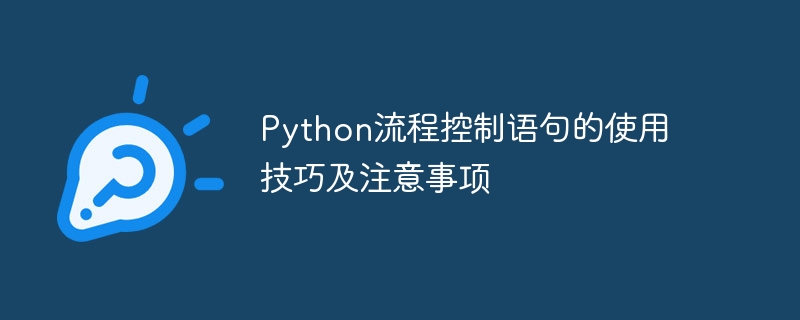

Tips and precautions for using Python flow control statements
As a high-level programming language, Python flow control statements are an important tool for realizing program logic. Mastering the use of flow control statements can improve the readability and efficiency of the code. This article will introduce the usage skills of Python's commonly used flow control statements if, for and while, and provide corresponding code examples.
1. If statement
The if statement is one of the most commonly used flow control statements in Python, which is used to execute different code blocks based on conditional judgments.
Grammar format:
if 条件:
代码块Sample code:
score = 90
if score >= 60:
print("及格了")Output result:
及格了
Grammar format:
if 条件1:
代码块1
elif 条件2:
代码块2
else:
代码块3Sample code:
score = 85
if score >= 90:
print("优秀")
elif score >= 80:
print("良好")
elif score >= 60:
print("及格")
else:
print("不及格")Output result:
良好
2. for Loop statement
The for loop statement is an important tool in Python for traversing sequence objects such as lists, tuples, and strings.
Syntax format:
for 变量 in 列表:
代码块Sample code:
fruits = ['apple', 'banana', 'orange']
for fruit in fruits:
print(fruit)Output result:
apple banana orange
Grammar format:
for 键, 值 in 字典.items():
代码块Sample code:
person = {'name': '张三', 'age': 20, 'gender': '男'}
for key, value in person.items():
print(key, value)Output result:
name 张三 age 20 gender 男
3. while loop statement
The while loop statement is an important tool in Python for looping blocks of code. It decides whether to continue executing the loop based on whether the condition is met.
Grammar format:
while 条件:
代码块Sample code:
count = 0
while count < 5:
print(count)
count += 1Output result:
0 1 2 3 4
4. Precautions
Summary:
This article introduces the usage skills of Python flow control statements if, for and while, and gives corresponding code examples. I hope that by studying this article, readers can master the usage of Python flow control statements and improve the efficiency and readability of the code. At the same time, when using flow control statements, you must also pay attention to the indentation of the code, the order of condition judgments, and the judgment of loop conditions to ensure the correct execution of the program.
Reference materials:
Python official documentation: https://docs.python.org/3/tutorial/controlflow.html
The above is the detailed content of Detailed explanation of techniques and precautions for Python flow control statements. For more information, please follow other related articles on the PHP Chinese website!
 How to use python for loop
How to use python for loop
 js gets current time
js gets current time
 What does pycharm mean when running in parallel?
What does pycharm mean when running in parallel?
 css3transition
css3transition
 Introduction to the main work content of front-end engineers
Introduction to the main work content of front-end engineers
 How to connect php to mssql database
How to connect php to mssql database
 The difference between Hongmeng system and Android system
The difference between Hongmeng system and Android system
 How to open the download permission of Douyin
How to open the download permission of Douyin
 tim mobile online
tim mobile online




